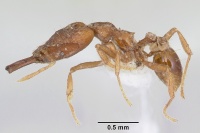Strumigenys hyletha
| Strumigenys hyletha | |
|---|---|

| |
| Scientific classification | |
| Kingdom: | Animalia |
| Phylum: | Arthropoda |
| Class: | Insecta |
| Order: | Hymenoptera |
| Family: | Formicidae |
| Subfamily: | Myrmicinae |
| Tribe: | Attini |
| Genus: | Strumigenys |
| Species: | S. hyletha |
| Binomial name | |
| Strumigenys hyletha Bolton, 2000 | |
Nothing is known about the biology of Strumigenys hyletha.
Identification
Bolton (2000) – A member of the koningsbergeri complex in the Strumigenys koningsbergeri-group. See Strumigenys chorosa.
Keys including this Species
Distribution
Distribution based on Regional Taxon Lists
Indo-Australian Region: Indonesia (type locality).
Distribution based on AntMaps
Distribution based on AntWeb specimens
Check data from AntWeb
Countries Occupied
| Number of countries occupied by this species based on AntWiki Regional Taxon Lists. In general, fewer countries occupied indicates a narrower range, while more countries indicates a more widespread species. |

|
Estimated Abundance
| Relative abundance based on number of AntMaps records per species (this species within the purple bar). Fewer records (to the left) indicates a less abundant/encountered species while more records (to the right) indicates more abundant/encountered species. |

|
Biology
|
Castes
Nomenclature
The following information is derived from Barry Bolton's Online Catalogue of the Ants of the World.
- hyletha. Strumigenys hyletha Bolton, 2000: 843, figs. 447, 487, 502 (w.) INDONESIA (Sumatra).
Unless otherwise noted the text for the remainder of this section is reported from the publication that includes the original description.
Description
Worker
Holotype. TL 2.7, HL 0.80, HW 0.65, CI 81, ML 0.40, MI 50, SL 0.46, SI 71, PW 0.32, AL 0.72. With characters of koningsbergeri-complex. Preocular concavity forms a broad depression on ventral surface of head. Upper scrobe margins evenly divergent posteriorly, shallowly convex above eye; most of outer arc of eye visible in full-face view but its inner margin mostly concealed by the scrobe margin. Edge of upper scrobe margin without a row of triangular teeth and lacking a decidedly jagged appearance. Depression across posterior vertex of head broad and shallow. Pronotum with a pair of short standing hairs close to anterodorsal margin. Pronotal humeral hair stiff, straight and simple. A single erect pair of hairs on mesonotum. Katepisternum and at least upper half of metapleuron smooth. Bullae of femoral glands absent on middle and hind legs. Lamella on propodeal declivity narrow, its posterior (free) margin concave. Standing hairs on first gastral tergite narrowly long-spatulate or their distal sections flattened and broadening to the apex; apices blunt, truncated or frayed.
Paratypes. TL 2.7-2.8, HL 0.79-0.86, HW 0.63-0.69, CI 80-83, ML 0.38-0.42, MI 48-50, SL 0.43-0.48, SI 67-71, PW 0.30-0.33, AL 0.70-0.78 (5 measured).
Type Material
Holotype worker (upper specimen of two on pin), Indonesia: Sumatra, Jambi, km. 15 Sungaipenuh to Tapan, 1450 m., 9.xi.1989, #10 (Agosti, Lobl & Burckhardt) (Musee d'Histoire Naturelle Genève). Paratypes. 10 workers with same data as holotype (MHNG, The Natural History Museum).
References
- Bolton, B. 2000. The ant tribe Dacetini. Memoirs of the American Entomological Institute. 65:1-1028. (page 843, figs. 447, 487, 502 worker described)
- Musfira, S.H., Rafi, M., Gusti, M., Putri, D.H., Satria, R. 2022. New data on the genus Strumigenys (Hymenoptera: Formicidae) from Sumatra. Zoosystematica Rossica 31(1): 74–86 (doi:10.31610/zsr/2022.31.1.74).
- Tang, K. L., Guénard, B. 2023. Further additions to the knowledge of Strumigenys (Formicidae: Myrmicinae) within South East Asia, with the descriptions of 20 new species. European Journal of Taxonomy 907, 1–144 (doi:10.5852/ejt.2023.907.2327).
References based on Global Ant Biodiversity Informatics
- Bolton B. 2000. The ant tribe Dacetini. Memoirs of the American Entomological Institute 65: 1-1028.

